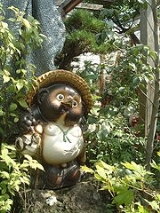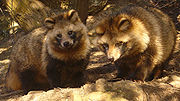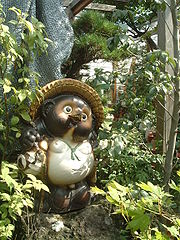
Tanuki
Encyclopedia

Japanese language
is a language spoken by over 130 million people in Japan and in Japanese emigrant communities. It is a member of the Japonic language family, which has a number of proposed relationships with other languages, none of which has gained wide acceptance among historical linguists .Japanese is an...
name for the Japanese raccoon dog
Japanese Raccoon Dog
The Japanese raccoon dog, also known as in Japanese, is conventionally considered as two subspecies of the raccoon dog, hondo-tanuki , and ezo-tanuki . Their common Japanese name is often mistakenly translated into English as "badger" or "raccoon"...
(Nyctereutes procyonoides viverrinus). They have been part of Japanese folklore
Japanese folklore
The folklore of Japan is heavily influenced by both Shinto and Buddhism, the two primary religions in the country. It often involves humorous or bizarre characters and situations and also includes an assortment of supernatural beings, such as bodhisattva, kami , yōkai , yūrei ,...
since ancient times. The legendary tanuki is reputed to be mischievous and jolly, a master of disguise and shapeshifting
Shapeshifting
Shapeshifting is a common theme in mythology, folklore, and fairy tales. It is also found in epic poems, science fiction literature, fantasy literature, children's literature, Shakespearean comedy, ballet, film, television, comics, and video games...
, but somewhat gullible and absentminded.
"Tanuki" is often somewhat mistakenly translated as raccoon
Raccoon
Procyon is a genus of nocturnal mammals, comprising three species commonly known as raccoons, in the family Procyonidae. The most familiar species, the common raccoon , is often known simply as "the" raccoon, as the two other raccoon species in the genus are native only to the tropics and are...
or badger
Badger
Badgers are short-legged omnivores in the weasel family, Mustelidae. There are nine species of badger, in three subfamilies : Melinae , Mellivorinae , and Taxideinae...
into English, animals which are similar to tanuki (which is a canine) in appearance, but actually belong to different Carnivora
Carnivora
The diverse order Carnivora |Latin]] carō "flesh", + vorāre "to devour") includes over 260 species of placental mammals. Its members are formally referred to as carnivorans, while the word "carnivore" can refer to any meat-eating animal...
families.
Folklore

Promissory note
A promissory note is a negotiable instrument, wherein one party makes an unconditional promise in writing to pay a determinate sum of money to the other , either at a fixed or determinable future time or on demand of the payee, under specific terms.Referred to as a note payable in accounting, or...
or empty purse in the other hand. Tanuki statues always have large bellies. The statues also usually show humorously large testicle
Testicle
The testicle is the male gonad in animals. Like the ovaries to which they are homologous, testes are components of both the reproductive system and the endocrine system...
s, typically hanging down to the floor or ground, although this feature is sometimes omitted in contemporary sculpture.
The comical image of the tanuki is thought to have developed during the Kamakura era
Kamakura period
The is a period of Japanese history that marks the governance by the Kamakura Shogunate, officially established in 1192 in Kamakura by the first shogun Minamoto no Yoritomo....
. The actual wild tanuki has disproportionately large testicles, a feature that has inspired humorous exaggeration in artistic depictions. Tanuki may be shown with their testicles flung over their backs like travelers' packs, or using them as drum
Drum
The drum is a member of the percussion group of musical instruments, which is technically classified as the membranophones. Drums consist of at least one membrane, called a drumhead or drum skin, that is stretched over a shell and struck, either directly with the player's hands, or with a...
s. As tanuki are also typically depicted as having large bellies, they may be depicted as drumming on their bellies instead of their testicles — particularly in contemporary art.

Kamakura period
The is a period of Japanese history that marks the governance by the Kamakura Shogunate, officially established in 1192 in Kamakura by the first shogun Minamoto no Yoritomo....
and Muromachi eras, some stories began to include more sinister tanuki. The Otogizōshi
Otogizoshi
refers to a group of approximately 350 Japanese prose narratives written primarily in the Muromachi period . These illustrated short stories, which remain unattributed, together form one of the representative literary genres of the Japanese medieval era.-Overview:This type of short prose narrative...
story of "Kachi-kachi Yama
Kachi-kachi Yama
Kachi-Kachi Yama , is one of the few Japanese folktales in which a tanuki is the villain, rather than the boisterous, well-endowed alcoholic.-The trouble-making tanuki:As the story goes, a man caught a troublesome tanuki in...
" features a tanuki that clubs an old lady to death and serves her to her unknowing husband as "old lady soup," an ironic twist on the folkloric recipe known as "tanuki soup." Other stories report tanuki as being harmless and productive members of society. Several shrines have stories of past priests who were tanuki in disguise. Shape-shifting tanuki are sometimes believed to be tsukumogami
Tsukumogami
Understood by many Western scholars as a type of Japanese yōkai, the Tsukumogami was a concept popular in Japanese folklore as far back as the tenth century, used in the spread of Shingon Buddhism...
, a transformation of the souls of household goods that were used for 100 years or more.
A popular tale known as Bunbuku Chagama
Bunbuku Chagama
Bunbuku Chagama is a Japanese folktale about a raccoon-dog, or tanuki, that uses its shapeshifting powers to reward its rescuer for his kindness.-Story:...
is about a tanuki who fooled a monk by transforming into a tea-kettle. Another is about a tanuki who tricked a hunter by disguising his arms as tree boughs, until he spread both arms at the same time and fell off the tree. Tanuki are said to cheat merchants with leaves they have magically disguised as paper money. Some stories describe tanuki as using leaves as part of their own shape-shifting magic.
The tanuki has eight special traits that bring good fortune, possibly created to coincide to the "Hachi" symbol (meaning eight) often found on the sake bottles the statues hold.
The eight traits are: a hat to be ready to protect against trouble or bad weather; big eyes to perceive the environment and help make good decisions; a sake bottle that represents virtue; a big tail that provides steadiness and strength until success is achieved; over-sized testicles that symbolize financial luck; a promissory note that represents trust or confidence; a big belly that symbolises bold and calm decisiveness; and a friendly smile.
A common schoolyard song in Japan makes explicit reference to the tanuki's anatomy:
- Tan Tan Tanuki no kintama wa,
- Kaze mo nai no ni,
- Bura bura
-
- " ' Tan-tan-tan ', tanuki's bollocks ring:
- The wind stops blowing but they swing, swing, swing. "
It continues for several verses, with many regional variations. It is sung to the melody of an American Baptist hymn called "Shall We Gather at the River?
Shall We Gather at the River?
"Shall We Gather at the River?" is a traditional Christian hymn, written by American poet and gospel music composer Robert Lowry . It was written in 1864....
".
In metalworking
Metalworking
Metalworking is the process of working with metals to create individual parts, assemblies, or large scale structures. The term covers a wide range of work from large ships and bridges to precise engine parts and delicate jewelry. It therefore includes a correspondingly wide range of skills,...
, tanuki skins were often used for thinning gold. As a result, tanuki became associated with precious metals and metalwork. This is also why tanuki are described as having large kintama ( literally gold ball, meaning testicles in casual Japanese). Small tanuki statues were marketed as a front yard decoration and good luck charm for bringing in prosperity.
Name

Mujina
is an old Japanese term primarily referring to the badger. In some regions the term refers instead to the Japanese raccoon dog or to introduced civets...
' onMouseout='HidePop("8235")' href="/topics/Kyujitai">kyujitai
Kyujitai
Kyūjitai, literally "old character forms" , are the traditional forms of kanji, Chinese written characters used in Japanese. Their simplified counterparts are shinjitai, "new character forms". Some of the simplified characters arose centuries ago and were in everyday use in both China and Japan,...
: 貉) can refer to raccoon dogs or badgers. An animal known as tanuki in one region may be known as mujina in another region. In modern Tokyo standard dialect, tanuki refers to raccoon dogs and anaguma refers to badgers. Regional dishes known as tanuki-jiru ("tanuki soup") may contain either raccoon dog or badger, although the taste of the latter is often preferred.
Originally, the kanji
Kanji
Kanji are the adopted logographic Chinese characters hanzi that are used in the modern Japanese writing system along with hiragana , katakana , Indo Arabic numerals, and the occasional use of the Latin alphabet...
for tanuki, (kyujitai
Kyujitai
Kyūjitai, literally "old character forms" , are the traditional forms of kanji, Chinese written characters used in Japanese. Their simplified counterparts are shinjitai, "new character forms". Some of the simplified characters arose centuries ago and were in everyday use in both China and Japan,...
: 貍) was used to refer to other mid-sized mammals, mostly wild cat
Wild cat
The wildcat is a small cat with several subspecies and a very broad distribution, found throughout most of Africa, Europe, and southwest and central Asia into India, China, and Mongolia. It is a hunter of small mammals, birds, and other creatures of a similar or smaller size. Sometimes included is...
s. Since wild cats live only in limited regions of Japan (e.g. Iriomote
Iriomote
Iriomote is the largest of the Yaeyama Islands and the second largest in Okinawa Prefecture after Okinawa Island itself....
, Okinawa
Okinawa Prefecture
is one of Japan's southern prefectures. It consists of hundreds of the Ryukyu Islands in a chain over long, which extends southwest from Kyūshū to Taiwan. Okinawa's capital, Naha, is located in the southern part of Okinawa Island...
), it is believed that the characters began to be used to mean "tanuki" instead starting around the Japanese feudal era. This shift in meaning, along with the rarity of the raccoon dog outside Japan, may have contributed to confusion over the proper translation of "tanuki" into other languages.
In Japanese slang, tanuki gao ("tanuki face") can refer to a face that looks like that of the animal, or a person's facial expression of feigned ignorance. Kitsune
Kitsune
is the Japanese word for fox. Foxes are a common subject of Japanese folklore; in English, kitsune refers to them in this context. Stories depict them as intelligent beings and as possessing magical abilities that increase with their age and wisdom. Foremost among these is the ability to assume...
gao ("fox face") refers to people with narrow faces, close-set eyes, thin eyebrows and high cheekbones.
Popular culture
- Both the animals and the mythic tanuki play a prominent role in Tom RobbinsTom RobbinsThomas Eugene "Tom" Robbins Thomas Eugene "Tom" Robbins Thomas Eugene "Tom" Robbins (born July 22, 1936 is an American author. His best-selling novels are serio-comic, often wildly poetic stories with a strong social and philosophical undercurrent, an irreverent bent, and scenes extrapolated from...
' Villa IncognitoVilla IncognitoBantam Doubleday Dell and Random House published Villa Incognito in April and June 2003, respectively. One of the most quoted lines from the book is the very first, setting the tone for this Tom Robbins adventure: "It has been reported that Tanuki fell from the sky using his scrotum as a...
. - The Studio GhibliStudio Ghibliis a Japanese animation and film studio founded in June 1985. The company's logo features the character Totoro from Hayao Miyazaki's film My Neighbor Totoro...
film Pom PokoPom Pokois a 1994 Japanese animated film, the eighth written and directed by Isao Takahata and animated by Studio Ghibli.Consistent with Japanese folklore, the tanuki are portrayed as a highly sociable, mischievous species, able to use "illusion science" to transform into almost anything, but too...
features a group of tanuki as the main characters. - The Japanese transformers series Beast Wars NeoBeast Wars NeoBeast Wars Neo is a 1998 Japanese Transformers television animated series and toy line, and a sequel to Beast Wars II.-Plot:The series focuses on a battle between Maximal and Predacon factions for possession of an energy source called Angolmois. The lone "one-man army" Big Convoy is assigned the...
featured a tanuki named Heinlad. - In the 1982 arcadeArcade gameAn arcade game is a coin-operated entertainment machine, usually installed in public businesses such as restaurants, bars, and amusement arcades. Most arcade games are video games, pinball machines, electro-mechanical games, redemption games, and merchandisers...
platform gamePlatform gameA platform game is a video game characterized by requiring the player to jump to and from suspended platforms or over obstacles . It must be possible to control these jumps and to fall from platforms or miss jumps...
PonpokoPonpokois a 1982 arcade game released by Sigma Enterprises. It is a platform game similar to Donkey Kong and Mario Bros..In Ponpoko, the player controls a , a Japanese Raccoon Dog, that can climb ladders, walk across floors and jump over gaps while trying to avoid red and yellow snakes. The player must...
, the player controls a tanuki. - In the video games Super Mario Bros. 3Super Mario Bros. 3, also referred to as Super Mario 3 and SMB3, is a platform video game developed and published by Nintendo for the Nintendo Entertainment System , and is the third game in the Super Mario series. The game was released in Japan in 1988, in the United States in 1990, and in Europe in 1991...
and Super Mario 3D Land, MarioMariois a fictional character in his video game series, created by Japanese video game designer Shigeru Miyamoto. Serving as Nintendo's mascot and the main protagonist of the series, Mario has appeared in over 200 video games since his creation...
can wear a "Tanooki Suit", which resembles a tanuki, complete with shape-shifting properties. - In Touhou ProjectTouhou ProjectThe , also known as Toho Project or Project Shrine Maiden, is a Japanese dōjin game series focused on bullet hell shooters made by the one-man developer Team Shanghai Alice, whose sole member, known as ZUN, is responsible for all the graphics, music, and programming for the most part...
, the character Mamizou Futatsuiwa based from Tanuki. She was a good friend of Nue Houjuu.
External links
- Entry on "tanuki" at The Obakemono Project
- Hyakumonogatari.com Translated tanuki stories from Hyakumonogatari.com
- Tanuki at The Portal of Transformation
- Entry on "tanuki" at The A-Z Dictionary of Japanese Buddhist Statuary
- "How the Wicked Tanuki was Punished" a folktale collected by Andrew LangAndrew LangAndrew Lang was a Scots poet, novelist, literary critic, and contributor to the field of anthropology. He is best known as a collector of folk and fairy tales. The Andrew Lang lectures at the University of St Andrews are named after him.- Biography :Lang was born in Selkirk...
.

